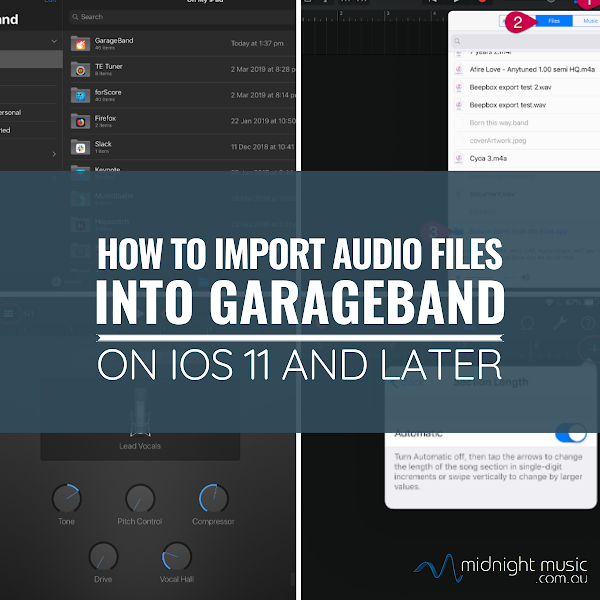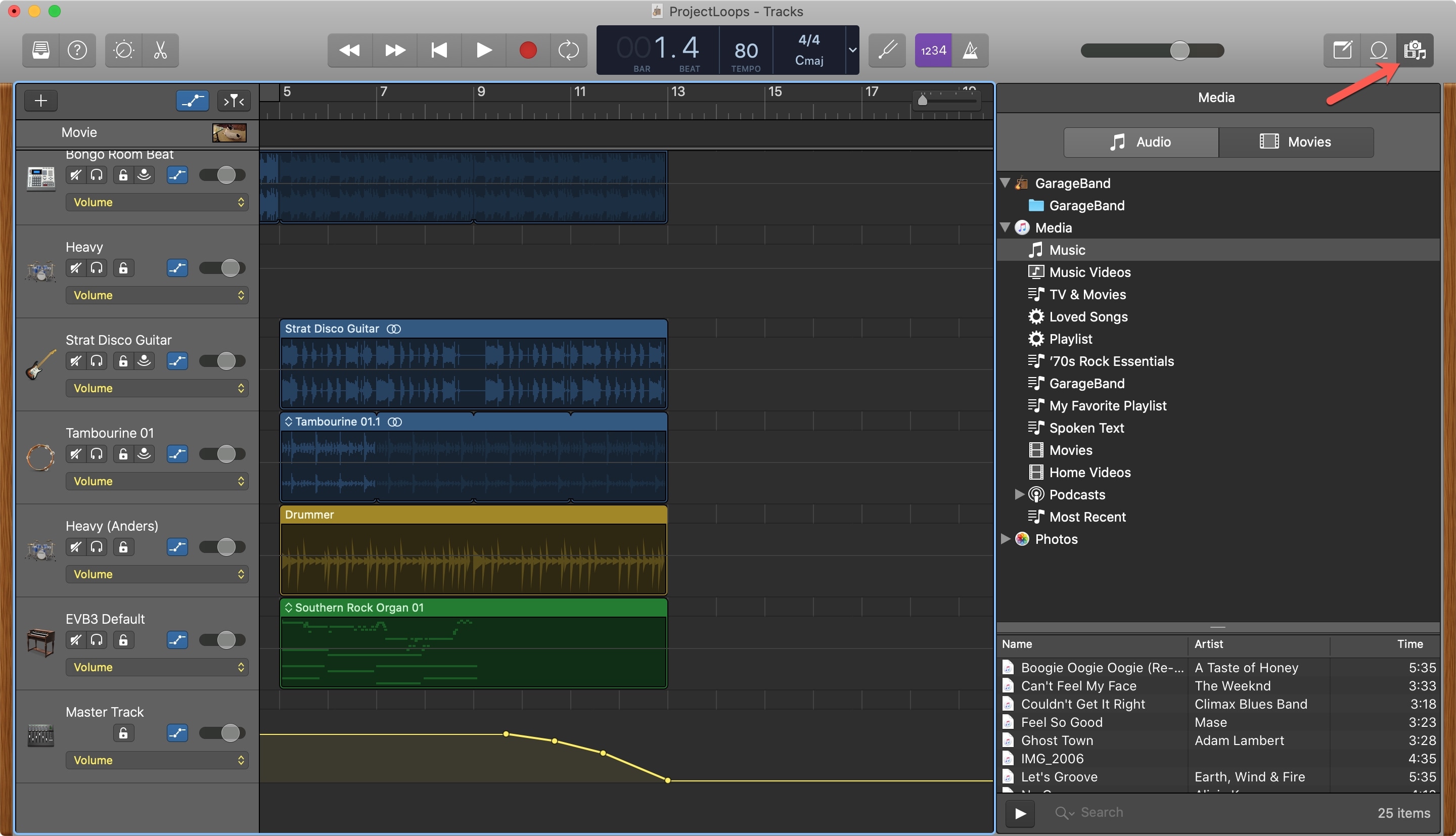Importing Files To Garageband Mac

For people who are familiar with this file extension, and know their way around Garageband, and who've had experience converting files (especially to and from PC/Mac), your assistance would be greatly appreciated.

I have never used a Windows-PC, but importing midi into GarageBand is not only a question of the file name extension, it is depending on the format of the midi file that you are trying to import.
Though I have a problem when importing long song-mini-files into Garageband. After about 8:30 all of the instruments just stop playing and I can't finish the song. Actually, the instruments stop but the Garageband-display tells me that the instruments are playing one single note each. Jan 10, 2015 I've downloaded some samples for making electric music and they're all wav. Files, but I don't know how I can import them into garageband 'library' (probably where all the apple's loops are) can somebody please help me??? This means that you can actually import GarageBand tiles to Logic. First, tap the “Edit” button on the top-right. Tap the “Share” icon in the top-left corner of the “My Songs” view of GarageBand. The application will ask you how you want to share the song “Share Song Via” and you have several choices. Nov 16, 2017 But, even when I simply rename the project or if i delete one track, and then put the file into iTunes sharing for GB, when I attempt to access them on the iPad, I get the message 'Cannot Open Song-This song was created with GarageBand on Mac and cannot be opened. I had already compiled some songs in a different app about a month ago, and wanted to use the AIFF files I had on my hard driive with GarageBand. To my surprise, there was no 'Import audio from file' option in the file menu. Looking at my GarageBand document 'My Song,' I noticed it was a package whose contents could be observed.
In any event, I've tried converting the .mid to a '.mp3' or a '.wav' or a '.aiff', and while I'm able to change the file extension, doing so renders to the file unplayable by anything, either QuickTime or iTunes.
Import Audio Files Garageband
You cannot change the encoding of a midi file by simply changing the extension. The file will remain midi and not change its formats, if you rename it '.aiff'.
Does the notation software you are using ( Tabit ) offer export options, when you export the midi? For example, I am using 'Finale' to create midi files - when I export from Finale with the 'Format 1: All instruments are saved as separate tracks' I can import the midi directly to GarageBand and each instrument appears on its own track, but with 'Format 0: All instruments are saved on a single tracks' the import to GarageBand fails. The 'Format 1' files I can drag directly into GarageBand's timeline and then assign suitable software instruments to the tracks from Instruments browser.
May 31, 2019 GarageBand for Mac Free Download: GarageBand for Mac is an excellent digital audio workstation app that lets you create incredible music from your Mac OS. Download GarageBand for Mac Free. With GarageBand Mac app, you can easily and efficiently create music or podcasts from your Mac. GarageBand is a fully equipped music creation studio right inside your Mac — with a complete sound library that includes instruments, presets for guitar and voice, and an incredible selection of session drummers and percussionists. Dec 25, 2019 Download GarageBand for Mac Direct Link for free Music is a part of life for many and for some their livelihood is dependent on music. There are a lot of people who use various modes of media to represent what they want to tell to the outside world and some of the popular ways are through music, podcasts, and video blogs. Garageband free on mac. Dec 21, 2019 This free Mac application was originally designed by Apple Inc. Our antivirus check shows that this Mac download is malware free. GarageBand for Mac can also be called 'GarageBand 9', 'GarageBand 2', 'Garage Band'. The unique identifier for this program's bundle is com.apple.garageband. First, the built-in mic’s location needs to be determined as the position differs across Mac models. Once found, a fresh GarageBand project must be opened, and then a fresh track box. Select Real Instrument to create a track. After creation, head to the track’s info pane on.
GarageBand understands the file name extension '.mid' as well as '.midi'.
If tabit let's you pick different midi options on export, try if saving in different format will help.
Regards
Léonie
Sep 24, 2012 11:40 PM
GarageBand User Guide for iPhone
You can import audio and MIDI files from your computer and use them in your GarageBand song. You can add:
Audio files to an existing Audio Recorder or Amp track
MIDI files to an existing Keyboard or Drums track
Audio or MIDI files to new tracks
Audio or MIDI files to your song from iCloud Drive or your iPhone using the Files app
When you import an audio file, it’s converted to a 44.1 kHz sample rate, 16-bit depth format if the original format is different. Imported audio files don’t follow tempo changes you make in GarageBand.
When you import a multitrack MIDI file, GarageBand creates a new Keyboard track for each track in the MIDI file. The total number of resulting tracks cannot exceed 32 tracks. You cannot add multitrack MIDI files to cells in Live Loops.
Import audio and MIDI files from your computer
On your computer, add the audio or MIDI files you want to import to the GarageBand File Sharing area in the Finder.
Www.DubChampions.com Dub Champions Festival is a journey into the international musical phenomenon called “dub.” Characterized by heavy bass, drums, and the copious use of effects, producers become the artists and the mixing board becomes an instrument with this Jamaican art form. /lee-scratch-perry-subatomic-sound-system-live.html. Dub has also inspired countless genres from rap to rock to punk to dance music, and in the process has redefined the role of producer as artist. Here are recaps of festival workshops in conjunction with Dubspot featuring Mad Professor, Adrian Sherwood, Lee Scratch Perry, Pinch, and Subatomic Sound System.ABOUT DUB CHAMPIONS FESTIVALDub Champions Festival was founded in New York City by Subatomic Sound, and is dedicated to featuring the world’s greatest dub pioneers from Jamaica and every continent worldwide. The festival features both performances & educational workshops to exhibit how the music is created and has evolved from its 1970s, reggae roots to become a cornerstone of electronic bass music. It has superb horns and pounding percussion along with booming bass, blasting beats and blazing energy” – United Reggae Shot and edited by Realization Pro and ARVR Consultants Directed & produced by Dominic Cincotti VR 360 edits by Chris Nienow Co-produced by Emch of Subatomic Sound.
In GarageBand on your iPhone, set the current song section to Automatic to import the entire audio or MIDI file; otherwise, only the portion of the file that fits the current song section is imported.
After importing the audio or MIDI file, you can make the song section longer, then resize the region so more of it plays.
Tap the Tracks View button to open Tracks view, then tap the Loop Browser button in the control bar.
A message appears asking if you want to move the audio or MIDI files to the GarageBand File Transfer folder.
Tap Move Files.
The files are moved to the GarageBand File Transfer folder.
To preview an audio file, tap it in the list. You can control the preview volume with the slider at the bottom of the list.
Drag an audio or MIDI file left or right to show Tracks view. Align the left edge of the file with the bar or beat (on the ruler) where you want it to start playing.
A new region created from the audio or MIDI file is trimmed to the end of the current song section, unless the current song section is set to Automatic. You can make the song section longer or slow down the tempo, then resize the region so that more of it plays.
Import audio and MIDI files with the Files app
Set the current song section to Automatic to import the entire audio or MIDI file; otherwise, only the portion of the file that fits the current song section is imported.
After importing the file, you can make the song section longer, then resize the region so that more of it plays.
Tap the Tracks View button to open Tracks view, tap the Loop Browser button in the control bar, then tap Files.
Tap “Browse items from the Files app,” then locate and tap an audio or MIDI file to import it.
To preview an audio file, tap it in the list. You can control the preview volume with the slider at the bottom of the list.
Drag an audio or MIDI file left or right to show Tracks view. Align the left edge of the file with the bar or beat (on the ruler) where you want it to start playing.
A new region created from the audio or MIDI file is trimmed to the end of the current song section, unless the current song section is set to Automatic. You can make the song section longer or slow down the tempo, then resize the region so that more of it plays.